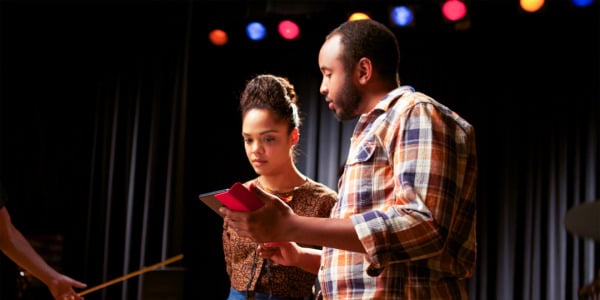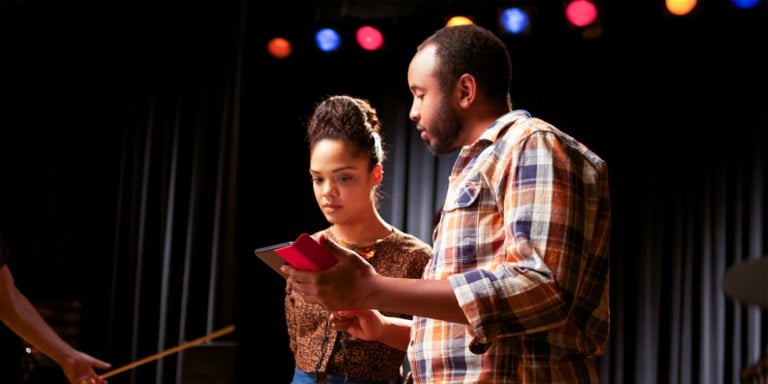
Writer-director Justin Simien’s first feature, the brilliant and hilarious satire “Dear White People,” opens in The Bay Area on Friday. After premiering at the Sundance Film Festival in January, where it won the U.S. Dramatic Special Jury Award for Breakthrough Talent, Simien has been making the rounds on the US film festival circuit where the film has become a word-of-mouth hit, winning the Audience Award at the San Francisco International Film Festival in May.
The film follows four black characters who seem like archetypes – the militant Sam (Tessa Thompson), the student politician Troy (Brandon P. Bell), the gay journalist with an out-of-control afro Lionel (Tyler James Williams), and the girl who doesn’t want to be defined by being black Coco (Teyonah Parris) – but prove to be much more complicated than that. They’re all dealing with being a black face in a white place. It’s set at a fictional Ivy League college where racial tensions come to a head when a fraternity throws a “black”-themed party, complete with “purple drank” and white people in blackface. As much as the film is a satire about race and a how-to-guide for not being racist, the film has a lot more to say, generally, about identity.
We sat down with Simien last week to discuss the film, his directorial choices and the performance of identity.
The Stanford Daily: How did you approach the aesthetic of the film? One of the things that really stood out was how you often shoot the characters from below, and a lot of the time, when you’re seeing some of the protagonists alone, or having a moment to themselves, you’ll have this really tight closeup and then, sort of, slowly reveal the situation that they’re in.
Justin Simien (JS): To me, I see the movie as being about identity and the relationships between identity and who we really are. Because of that, visually, the film is attempting to say something about the artifice of identity, the theatricality of identity, the presentational nature of identity. It’s a satire, so it’s a heightened reality already, but visually, it was important for me to really push that to where, literally, the film is presenting people to you. In the beginning of the movie, I wanted to present these archetypes, these beautiful but almost, like, paper-thin sort of portraits of people that we then, kind of, get to go into further as the story continues.
Another influence on the visual style is that the movie is very intentionally referential. I saw these characters as characters who pick and choose different cultural queues to create their identities. Sam is really giving you Lisa Bonet from “The Cosby Show” one day, Annie Hall the next day.
Everyone is sort of like a pastiche of all these other ideas, so the film, often-times, will make reference to other movies, particularly with Sam. The box office scene is the best example. We’re literally, directly, visually quoting Fritz Lang’s “Metropolis.” We also do some quoting of Ingmar Bergman’s film “Persona.” I also do some quoting from Stanley Kubrick’s “Barry Lyndon” with Troy.
So just, in general, I felt the movie should be referential, and it should be very presentational. It should just admit to you from the very beginning that you’re watching a movie. And that’s really where a lot of those choices came from.
TSD: I did feel like so much of it is creating this stage for the characters to perform on, whether that’s Sam or Troy actually literally on stage, giving a speech, with the bright lights above, or even when they’re at lunch tables, you’ve got three or four people sitting at the table, and then the camera is looking right at them, as if they’re performing.
JS: Yeah, there’s a lot of those group shots because the movie is about identity and the ways we group with each other around identity. So often-times, say, in that cafeteria scene, I wanted to show the group. I didn’t want to do the typical wide shot, medium shot, coverage, coverage, coverage. I wanted it to be this group vs. that group vs. that group, so that people are kind of aligned within the shot in very intentional ways. So when we cut them together, they’re almost pointing at direct angles at each other, just in the way that people are situated.
TSD: Going back to the idea of the internal audiences within the movie, there seem to be those in a lot of different scenarios – one of them is at the box office of the movie theatre. I’m wondering how you decided where you needed to have an audience within the film and what you wanted that audience to look like.
JS: A lot of times, when characters are looking directly into lens, that scene is saying something about how those characters are seeing themselves through the lens of how they feel seen by other people. And in this case, we audience members, unbeknownst to them, are sort of watching them and making judgments of them. And they are unaware of us sort of responding to how they think others will see them.
There’s something about a character in a film looking directly at you that’s very powerful. And I’ve always sort of worked it in somehow. I really like it, it made a lot of sense in the film to me. I’ve referenced “Metropolis” many times: [characters looking directly into lens] is done a lot in that film. Wes Anderson I think is an obvious sort of parallel. He does it a lot. They do it in “Amelie.” It was kind of popular in the ‘90s, to be honest, but it’s a part of cinema history. And Spike Lee did it. I think particularly with auteur, art-house cinema, the idea that the object of a narrative makes us the object, by looking at us, is not a terribly new idea, but it’s one that I love and felt fit nicely within the aesthetic of the film.
TSD: So what is your process when you’re shooting? Do you care about shooting in order? Or is that something that’s more just budget restrictions may not allow that?
JS: With this one, I couldn’t impose too much process because we were sort of at the whim of a very limited budget, very limited resources, very limited time. But, for me, the process is sort of really drilling down every scene to its very core, essential bit, and knowing, in terms of the narrative, how does the scene move us forward, which is just the structural meat and potatoes of it. And, thematically, how does it touch upon the themes of the film in a way that’s new. Like, what’s the addition to what we’re saying that this scene is bringing. And where those things intersect, I call the core of the scene. And the core of the scene for me, finding that out for every single scene, and as a writer, the awareness of that, is different than as a director, even though I’m both on this film. So drilling it down to the core of the scene and trying to innovate, as much as we can, [making] creative decisions around [what will] best serve the core of the scene.
Sometimes, I can come up with really great ideas that I think would be amazing, and I get to set, and we have an hour to shoot that day, so, like, sorry, we’ve gotta improvise. But I at least do that preparation first, and with this film, I culled a lot of different references. Whenever we were quoting another film, obviously, I pooled a lot of things to reference in these scenes. We couldn’t afford a storyboard artist so a lot of times, I had this very expansive mood board for every scene. Sometimes it was scenes from other movies, and sometimes it was pieces of art – sometimes it was poetry. But I tried to make sure that all of my departments had a very clear picture, like kind of on a soul level, of how I saw each scene, because we didn’t really have the benefit of storyboarding everything and being able to meet enough until everyone clearly understood it.
TSD: And did that extend to the rhythm of the film? I’ve heard some directors talk about how there’s a certain piece of music that you’re listening to when you’re deciding how to think about the scene, and that that’s sort of how you find the rhythm of the scene. And, of course, in this film, where so much of the delivery is so timing-dependent, how do you figure that out?
JS: It’s multilayered. When I’m writing, I definitely have the soundtrack completely figured out. Every scene has music, just when I’m writing. I mean, I hum things out, particularly classical music. I’ll hum a melody in my head when I’m writing a scene. I don’t know why; they’re just very much related. But then when you actually get to make the movie you can’t always afford… You don’t necessarily have the rights to that song. Even classical music, and particular takes on some classical songs, you just don’t have the rights. So then it’s a whole other process. I guess music is a part of it.
Part of it is just how it plays in my head, and there’s a rehearsal process, and sort of weeding out the things that don’t work in that process. And then, there’s the editing process, of further refining it. I think it’s something that you have best intentions, but you really kind of correct and self-correct along the way.
“Dear White People” opens in the Bay Area on Friday, Oct. 24, at Century 20 Redwood City Downtown, Camera 12 and Santana Row 6 in San Jose, Century 16 Mountain View, and Metreon and Sundance Kabuki in San Francisco.
Contact Alexandra Heeney at aheeney ‘at’ stanford.edu
